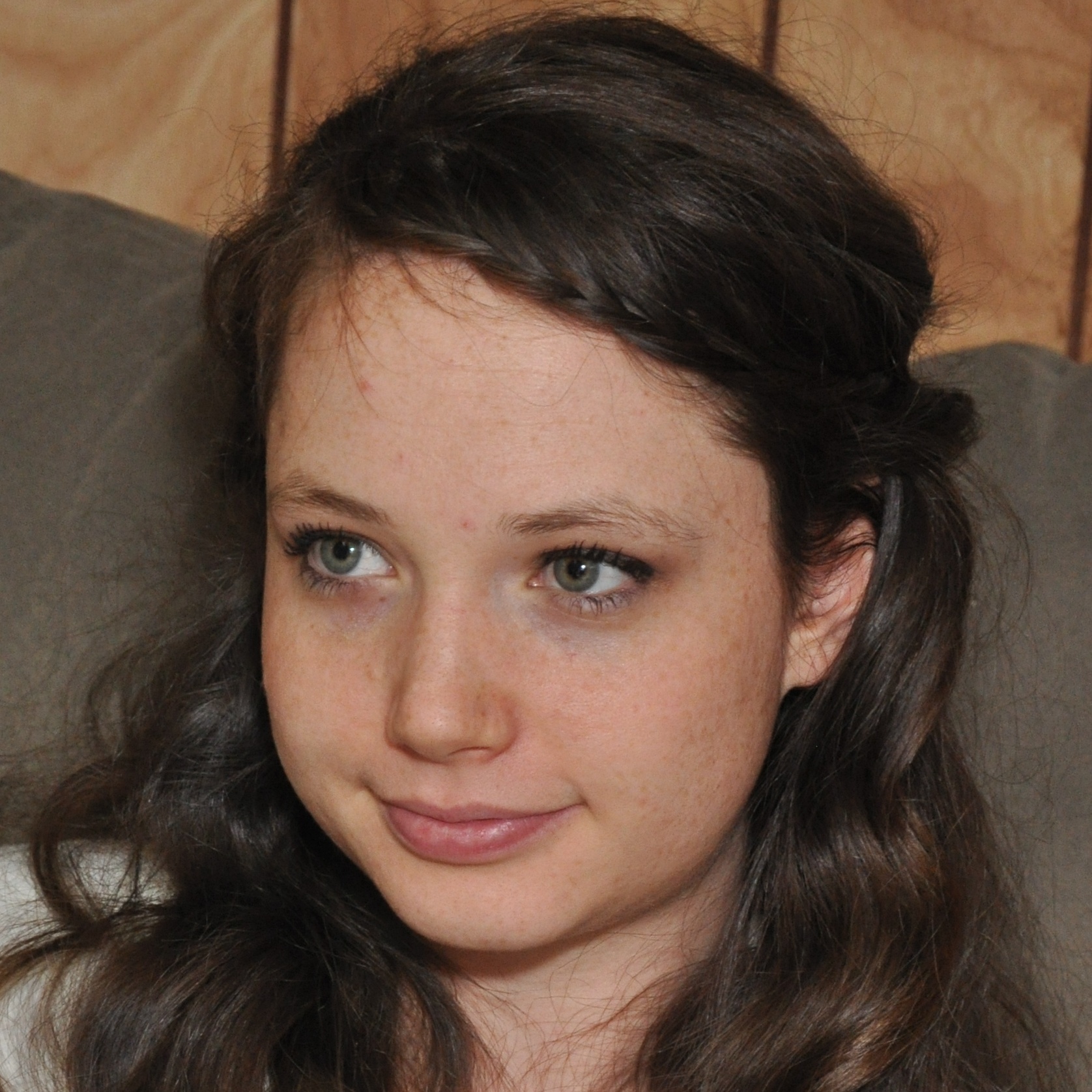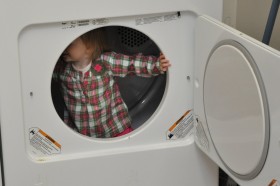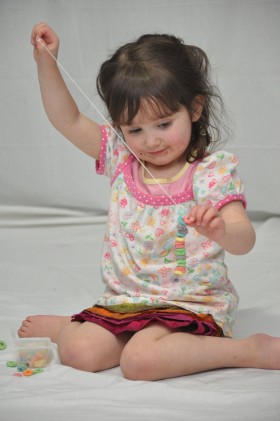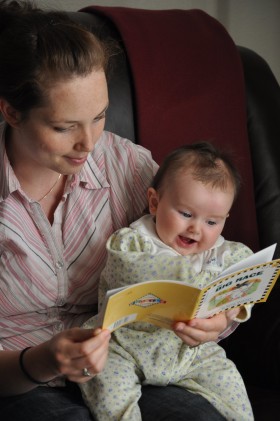
My guest writer today is Ada, a stay-at-home mother of two rambunctious preschoolers. Ada enjoys spending time with her family, cooking, and reading when she’s not playing Mommy.
Creativity is used every day, in every aspect of our lives. When we think of creativity, we usually think of it in the context of art, but according to Wikipedia, creativity is “the phenomenon whereby a person creates something new (a product, a solution, a work of art, a novel, a joke, etc.) that has some kind of value.”
What does this mean to me? It means that if I want to raise a child who can solve her own problems, she needs to be creative. I feel that creativity is a necessary component of a child’s education, but how do we raise a creative child?
Foster Exploration
 Some children may seem to be born more creative than others; however, their creative tendencies are likely due to an environment that is open to creative expression, rather than stifling the child’s explorations.
Some children may seem to be born more creative than others; however, their creative tendencies are likely due to an environment that is open to creative expression, rather than stifling the child’s explorations.
In our home, we foster an atmosphere of stimulation. If my three-year-old wants to color the grass pink, because it’s her favorite color, I don’t say, “grass is green, not pink.” This would stifle her creative exploration.
And instead of having a long list of items within reach that they can’t touch, we set out items that they can touch, feel, sense – in essence, explore.
Fun in Exercise
 Just as a child needs to exercise her muscles to help them grow, creative “muscles” need stretching and exercising.
Just as a child needs to exercise her muscles to help them grow, creative “muscles” need stretching and exercising.
Exercising our muscles can either be a grueling, hard and painful experience or a fun and enjoyable experience.
Likewise, exercising our child’s mind can either be tedious or joyful.
Have fun with your child – play games that will provoke thought and imagination, let them explore, or give them a bunch of objects and just let them create.
Reading, Writing, and a Rhythm
Several studies have indicated that reading to children before preschool-aged will help them do well in all facets of formal education, as well as helping them to have basic speech skills.
The other night my 3-year-old came up to me and said, “Mommy, I’m not feeling well. I can’t eat my dinner.” Really she just wanted dessert, but I was impressed with her proper use of grammar, her sentence structure, as well as her solution.
 When reading with a child, try the following:
When reading with a child, try the following:
- Ask questions. “Where’s the bird?”, “What is that man doing?”, or “What is going to happen next?”
- Let the child fill in the blanks. “Itsy Bitsy Spider went up the water ______.” (Pause and let the child say “spout”.)
- Let them “read” to you. Even if the child can’t read words, they can make up their own story using the pictures. You’d be amazed with how much of the story they pick up from listening to you read it to them.
- Have toddlers and preschoolers act out the story or draw it.
What are some other ways to promote creativity in our children?
Update
23 July 2017 — Changed the author’s image and removed a dead links.
Thank you for the opportunity to post!
You practice what you post, I have seen you using these principles on your children.
You could let them eat horse meat, that is similar to pink grass I think.
Little children like to ride horses, not eat them.
I once gave Aurora meatballs and she said, “Yes! Eyeballs!”
Good piece. I enjoyed it.
When I think about creativity, an essence that I will define as:
The assemblage of thoughts leading to production of some enterprise that invokes an observer to conclude, “I never thought of it in that way”
– is the product of experience.
We can’t teach creativity although we can teach skills.
When one sees a great painting, the greatness depends not only on creativity but relies heavily upon the artist’s choice of materials, and the artist’s ability to manipulate the materials and the tools they choose.
Without creativity, an art piece, or a speech, or song, may be technically awe inspiring but lack the inspiration that thrills you.
Here is how the thrill happens. A breadth of experience and skills give us the tools to be creative. However, for the oeuvre to be extraordinary requires an ability to imagine possibilities and a curious mind to motivate the production of creative work.
I like your definition of creativity. While we may not be able to teach it, I feel that everyone is born with creativity. Have you ever watched a young child play? I agree that we can teach children skills that will enable them to practice their creativity, which will motivate them to produce creative work. This is what I’m proposing that we, as a society, need to do. I appreciate your comments. Very thought-provoking!
Yours is certainly a creative comment.
So are we born creative or do we learn it? I would say we nurture the latent creativity we all have by doing. With young children it is also a question of allowing them to do, as Ada pointed out.
Some adults may get lazy and cease to be creative. Their idea of creativity is to try a different television channel.
You summed it up well with your “imagine possibilities and a curious mind to motivate.”
Rick acknowledges the existence of creativity and extends the discussion to the “which came first” conundrum – innate or learned.
Without any evidence or research, I will casually take a crack at the question relying upon my experience.
To begin, I will conjecture that most of us, excluding genetic damage or misfortune, or accidents, ever come close to reaching our capacity to develop our intellect and skill. Moreover, the sum of our experiences, and study, simply give us a greater archive upon which we can draw information to arrive at creative solutions.
Allow me a couple of examples: My artist daughter and I can look at the same scene or object that we snap a picture of. Her picture will usually look much better than mine. Is there an innate difference in our nature?
Venturing a supposition, I posit Daughter sees things that I don’t see because of her training and experience as an artist. Additionally, I will deduce an inference from my observations using art as a source to analogize the point. Here goes.
Study for a new artist begins with some simple exercises leading to drawing skillfully. One exercise is to view an object while rapidly filling in and sketching a continuously moving line that identifies and places the masses of the object on paper.
http://drawsketch.about.com/od/drawinglessonsandtips/ss/gesturaldrawing.htm
“The term “gesture drawing” means somewhat different things to different people, but the defining characteristics are that the drawing is done quickly and that its purpose is to capture the essence of subject, rather than to present a realistic rendering of details.”
The second technique is to view an object while tracing the edges very slowly drawing a line capturing every nuance of the contour. Time is of no importance because the goal is to see and capture every gradation of change.
The gift of the exercise is to develop hand-eye coordination and cause one to see every facet of the object. Continued practice further reinforces the rote act of drawing until it becomes a learned response.
Simply put, one learns to see more in what they observe. Here are some words describing the characteristics of lines:
http://artworkinparis.tripod.com/index-10.html
There are other generally accepted conventions such as not allowing the observer’s eye to leave the page boundaries. Rather, position objects in the composition so they cause the eye to move from one to the other. Conventionally, the notion is that the eye wants to be entertained by moving and discovering new things. I take no issue with that convention.
Try it for yourself by analyzing your experience looking at a drawing or painting or picture and identify what is there that pleases you, or annoys you, and where your eye rests. Moreover, vary the slit of your vision by lowering your eyelids gradually diminishing the light reflected from the object so that you can locate the masses.
Regarding the Wikipedia definition of creativity, I depart somewhat, in that it is too restrictive about value, “…that has some kind of value.” Must creative thinking be valuable or have any value at all? Here are some examples that come to mind that quibble about value:
During the battle of Fallujah, Iraq, the Marines were facing an enemy that was well positioned to control movement of opposing soldiers and vehicles down streets that were heavily conditioned with explosive devices, barriers, and well positioned combatants using RPG’s and like weapons. The creative solution employed by the Marines was to avoid the streets and drive armored vehicles through the buildings creating a clear path to their target. I suppose one would agree that had value. It certainly was safer for the Marines.
Here is another:
Burglaries occur in all sorts of ways. Recently, in the newspapers, I noticed some miscreants were simply sawing an opening in the building’s frame wall to gain entry. Wooden framed building are common is this state of many trees. Moreover, battery powered portable tools are commonplace. Therefore, it is a simple task to saw through a frame wall in a matter of seconds to gain entry obviating the need to defeat double bolt door locks.
No doubt some miscreant with carpenter experience came up with that creative approach.
I rest my case.
I have read your comment carefully several times and cannot follow your case. Can you put it more simply?
Or perhaps your shock and awe response has destroyed my will to respond.
Explain the parts you aren’t clear about so that I can understand the question.
As I understand your comment, you are saying that creativity is learned. Then you give evidence, very well presented, to back up your claim. So I guess by attempting to summarize your case myself, I have answered my own question.
However, I am not convinced. Creativity is innate in everyone. With some it is drawn out, others it is dormant their whole lives. By my own experience I have come to know this.
Perhaps I am being rather bold in assuming that my experience is, or can be, universal.
No, I am not saying creativity is learned. I am saying I believe creativity evolves from study, experience, and the application thereof.
Rather than saying that directly in my earlier writing, I thought I could lead the reader through a series of steps to arrive at their own conclusion.
Had I made a direct statement, I would say that creativity is dimensionless. It has no metric we can apply such as how fast a runner can run or a baseball pitcher can throw a ball. Those acts are physical, measurable, and depend upon athleticism and sometimes innate features.
However, the notion of creativity is abstract and a judgment made by anyone bold enough to judge anything convincingly. It follows that creativity is a barrier that is inclusive for a self-proclaimed few that are successful in convincing everyone else of their privileged innate gifts. By inference, without those gifts, one can never be creative so why waste your time, and you wouldn’t understand anyway. How many times have you heard someone say they can’t do something because they aren’t creative?
If I had accepted everything the experts told me I couldn’t do, then I would be still be back in Missouri digging ditches for a dollar an hour.
I don’t allow anyone to define for me what is creative. And, I refuse to be constrained from trying whatever pleases me.
Therefore, I say why would anyone blindly fail to try something because they accept someone else’s judgment about what is creative – especially your precious children’s creativeness. Don’t keep them in a cage designed by others. Let them soar and fly without artificial boundaries.
Very good post!
It is awesome to encourage children to express themselves through being creative. I find it odd that society thinks a well behaved child is one that is quiet and does exactly what they are told. Children that aren’t free to express aren’t free to create!
Be quiet.
Thanks, Jake! I feel there are times when children should know how to sit still and and be obedient, but if we are constantly limiting their creativity, they will grow up as robots. Which maybe wouldn’t be so bad? Just kidding. I want children who grow up and get well-paying jobs because they know how to think outside the box.
It’s great to see like-minded parents. At my house bedtime stories were the norm. And my two boys (now 8 and 12) loved them. But it wasn’t always reading a story. Often I would create a story on the spot, then I would encourage my sons to add their own parts. Or better yet, come up with their own whole new story! We just finished making one of our favorite collaborative bedtime stories into a children’s video book, called Puddle Boy. Many elements came straight from the minds of children. Let me know what you think. http://www.youtube.com/watch?v=JNkfZ59DNWM